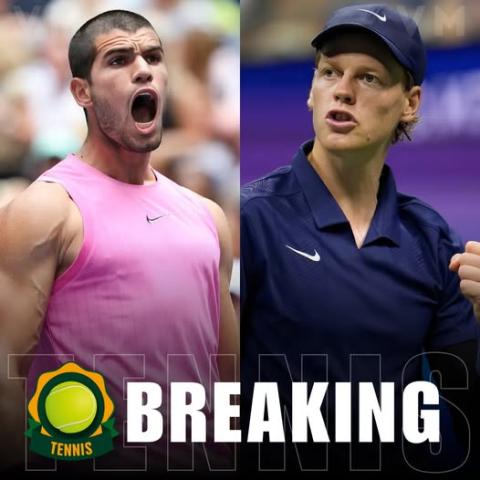
NEW YORK – The air on Arthur Ashe Stadium crackled with a voltage only a New York night can generate. It wasn’t just the record crowd or the blinding flashbulbs; it was the palpable weight of history-in-the-making. The dream final the tennis world had prophesied for years was finally here: Carlos Alcaraz versus Jannik Sinner. Not just for the 2025 US Open trophy, but for the soul of the sport's next era.
From the first warm-up, the contrast was stark. Sinner, the Iceman, with his flaming red hair and preternatural calm, moved with a fluid, ruthless economy. Across the net, Alcaraz, a bundle of explosive energy and audacious creativity, practiced drop shots as if they were a declaration of war. The stage was set for a clash of titans, a brutal battle of attrition. What unfolded, however, was a masterpiece of controlled chaos, orchestrated by the magical hands of Carlos Alcaraz.
The first set was a thunderclap. Sinner, leveraging his rock-solid baseline game and punishing flat shots, broke early. His supporters roared, believing this was the moment he would cement his status as the new world No. 1. But a shift occurred. Down 2-4, Alcaraz didn’t panic. He dug in. He began extending the rallies, using his heavy topspin to push Sinner back and disrupt his rhythm. Then came the magic. A breathtaking lob winner on the full sprint. A drop shot so delicate it seemed to die on contact with the blue court. He broke back, and in the ensuing tiebreak, he was untouchable, sealing it 7-3 with a ferocious cross-court pass. The stadium erupted. The momentum had swung.
The second set was where the narrative was rewritten. This was not a match of sheer power; it was a chess match played at 100 miles per hour, and Alcaraz was the grandmaster. He began to control the game with a terrifying blend of tactical intelligence and physical prowess. He used his serve not just to start points, but to dictate them, kicking it wide to Sinner’s backhand to open the court for his ferocious forehand.
He controlled the tempo, masterfully shifting from defensive wizardry—slicing and retrieving Sinner’s missiles—to all-out assault in a single shot. He controlled the space, pulling Sinner forward with feathery drops before launching devastating passing shots. Most importantly, he controlled the crowd. Every flick of his wrist, every impossible get, was met with a deafening wave of disbelief and adoration. He wasn't just playing tennis; he was conducting a symphony, and Arthur Ashe was his orchestra. A break at 4-3 was all he needed, clinching the set 6-4 with a hold to love.
Facing a two-set deficit, Sinner did what champions do: he fought back. The third set was a brutal display of resilience from the Italian. He found more depth on his groundstrokes, began to read the Alcaraz drop shot better, and held firm to take the set 6-4. Social media, already in flames, exploded. The doubters whispered: "Was the maestro cracking? Could the Iceman mount the great escape?"
The answer, delivered in the fourth set, was a resounding no.
If the second set was a display of control, the fourth was a coronation. With the finish line in sight, Alcaraz elevated his game to a stratospheric level. The forehand, a weapon of mass destruction, found its targets with unerring accuracy. The drop shot, once a risky trick shot, became a predictable, yet utterly unreturnable, tool of torture. He broke Sinner’s spirit and his serve in a breathtakingly long third game, saving three break points against him with courageous, first-strike tennis.
Serving for the championship at 5-3, the weight of the moment settled over the court. But Alcaraz was weightless. A 128 mph ace out wide. A unreturnable serve. Two points away. Then, on match point, it ended as it had to: a final, brutal forehand forcing a short reply from Sinner, which Alcaraz met with a vicious put-away. He dropped his racket, fell to his back, and stared up at the New York sky, a champion once more.
As the roar of the crowd washed over him, the two young warriors embraced at the net. They had pushed each other to the absolute limit, rewriting the definition of a modern rivalry. But on this night, one man had rewritten history on his own terms. Carlos Alcaraz didn’t just win the US Open; he authored it. With a blend of power, touch, and an uncanny ability to control the very fabric of the game, he didn't just prove he was the heir to the legends. He proved he is the legend of the future, and the future is now.
